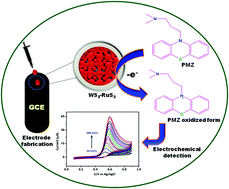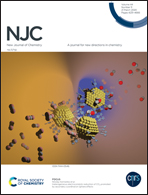Synergistic activity of binary metal sulphide WS2–RuS2 nanospheres for the electrochemical detection of the antipsychotic drug promazine†
Abstract
The authors describe the synthesis and application of a heterostructured binary nanomaterial composed of tungsten disulfide and ruthenium disulfide (WS2–RuS2). It was synthesized via a one-pot hydrothermal technique. Its morphology was investigated via field emission scanning electron microscopy, energy dispersive X-ray spectroscopy, transmission electron microscopy, elemental mapping, X-ray photo electron spectroscopy and X-ray diffraction. A glassy carbon electrode (GCE) was modified with the nanomaterial and used to quantify promazine (PMZ). The interfacial electron transfer activity and electrocatalytic behavior were probed via electrochemical impedance spectroscopy, cyclic voltammetry and amperometry. The modified GCE has a wide linear range (0.6 nM–870 μM), a low detection limit (0.2 nM), and good sensitivity (2.38 μA μM−1 cm−2). It was applied for the determination of PMZ in PMZ tablets and spiked serum samples.



 Please wait while we load your content...
Please wait while we load your content...